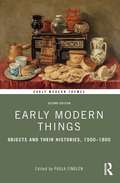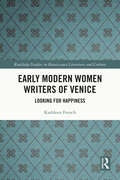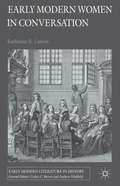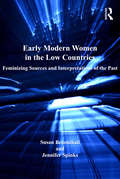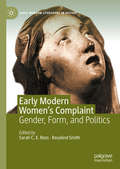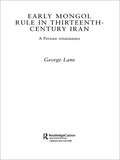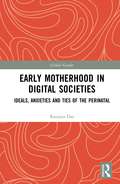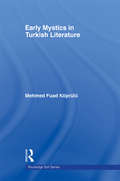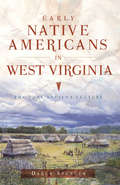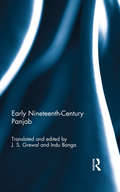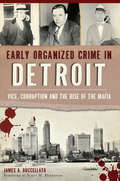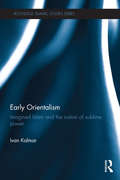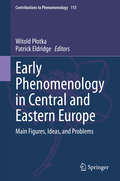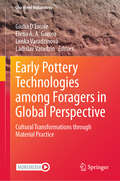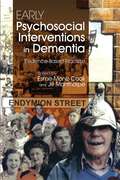- Table View
- List View
Early Modern Things: Objects and their Histories, 1500-1800 (Early Modern Themes)
by Paula FindlenEarly Modern Things supplies fresh and provocative insights into how objects – ordinary and extraordinary, secular and sacred, natural and man-made – came to define some of the key developments of the early modern world. Now in its second edition, this book taps a rich vein of recent scholarship to explore a variety of approaches to the material culture of the early modern world (c. 1500–1800). Divided into seven parts, the book explores the ambiguity of things, representing things, making things, encountering things, empires of things, consuming things, and the power of things. This edition includes a new preface and three new essays on ‘encountering things’ to enrich the volume. These look at cabinets of curiosities, American pearls, and the material culture of West Central Africa. Spanning across the early modern world from Ming dynasty China and Tokugawa Japan to Siberia and Georgian England, from the Kingdom of the Kongo and the Ottoman Empire to the Caribbean and the Spanish Americas, the authors provide a generous set of examples in how to study the circulation, use, consumption, and, most fundamentally, the nature of things themselves. Drawing on a broad range of disciplinary perspectives and lavishly illustrated, this updated edition of Early Modern Things is essential reading for all those interested in the early modern world and the history of material culture.
Early Modern Toleration: New Approaches (Early Modern Themes)
by Jaap GeraertsThis book examines the practice of toleration and the experience of religious diversity in the early modern world. Recent scholarship has shown the myriad ways in which religious differences were accommodated in the early modern era (1500–1800). This book propels this revisionist wave further by linking the accommodation of religious diversity in early modern communities to the experience of this diversity by individuals. It does so by studying the forms and patterns of interaction between members of different religious groups, including Christian denominations, Muslims, and Jews, in territories ranging from Europe to the Americas and South-East Asia. This book is structured around five key concepts: the senses, identities, boundaries, interaction, and space. For each concept, the book provides chapters based on new, original research plus an introduction that situates the chapters in their historiographic context. Early Modern Toleration: New Approaches is aimed primarily at undergraduate and postgraduate students, to whom it offers an accessible introduction to the study of religious toleration in the early modern era. Additionally, scholars will find cutting-edge contributions to the field in the book’s chapters.
Early Modern Women Writers of Venice: Looking for Happiness (Routledge Studies in Renaissance Literature and Culture)
by Kathleen FrenchEarly Modern Women Writers of Venice: Looking for Happiness explores the ways in which five women used their writing to challenge misogynistic views about female inferiority, develop a sense of agency, and form meaningful interpersonal relationships that would enable them to find happiness. They are the forerunners of later feminist thinkers.This book is the first full-length study of the happiness of women in early modern Italy. It focuses on five women writers who lived in Venice between the late fifteenth century and the early seventeenth century. It takes an interdisciplinary approach that combines methodologies from literature, psychology, philosophy, history, religion, and emotion studies, emphasizing the importance of studying the search for happiness within a specific cultural context. It contributes particularly to feminist studies that consider gender in the context of ideology and the exercise of power. It also engages with current studies of emotions by approaching them from the perspective of research in the field of positive psychology and self-determination theory. It considers how the process of writing enabled women to achieve autonomy, what they thought about happiness, and the extent to which they were able to achieve it in their individual lives.
Early Modern Women in Conversation
by Katherine R. LarsonTo converse is, in its most fundamental sense, to engage with society. The potency of conversation as an early modern social networking tool is complicated, however, both by its gendered status in the period and by its conflation of verbal and physical interaction. Conversation was an embodied act that signified social intimacy, cohabitation, and even sexual intercourse. As such, conversation posed a particular challenge for women, whose virtuous reputation was contingent on sexual and verbal self-control. Early Modern Women in Conversation considers how five women writers from the prominent Sidney and Cavendish families negotiated the gendered interrelationship between conversation and the spatial boundaries delimiting conversational encounters to create opportunities for authoritative and socially transformative utterance within their texts. Conversation emerges in this book as a powerful rhetorical and creative practice that remaps women's relationship to space and language inearly modern England.
Early Modern Women in the Low Countries: Feminizing Sources and Interpretations of the Past (Women and Gender in the Early Modern World)
by Jennifer Spinks Susan BroomhallCombining historical, historiographical, museological, and touristic analysis, this study investigates how late medieval and early modern women of the Low Countries expressed themselves through texts, art, architecture and material objects, how they were represented by contemporaries, and how they have been interpreted in modern academic and popular contexts. Broomhall and Spinks analyse late medieval and early modern women's opportunities to narrate their experiences and ideas, as well as the processes that have shaped their representation in the heritage and cultural tourism of the Netherlands and Belgium today. The authors study female-authored objects such as familial and political letters, dolls' houses, account books; visual sources, funeral monuments, and buildings commissioned by female patrons; and further artworks as well as heritage sites, streetscapes, souvenirs and clothing with gendered historical resonances. Employing an innovative range of materials from written sources to artworks, material objects, heritage sites and urban precincts, the authors argue that interpretations of late medieval and early modern women's experiences by historians and art scholars interact with presentations by cultural and heritage tourism providers in significant ways that deserve closer interrogation by feminist researchers.
Early Modern Women's Complaint: Gender, Form, and Politics (Early Modern Literature in History)
by Rosalind Smith Sarah C. E. RossThis collection examines early modern women’s contribution to the culturally central mode of complaint. Complaint has largely been understood as male-authored, yet, as this collection shows, early modern women used complaint across a surprising variety of forms from the early-Tudor period to the late-seventeenth century. They were some of the mode’s first writers, most influential patrons, and most innovative contributors. Together, these new essays illuminate early modern women’s participation in one of the most powerful rhetorical modes in the English Renaissance, one which gave voice to political, religious and erotic protest and loss across a diverse range of texts.This volume interrogates new texts (closet drama, song, manuscript-based religious and political lyrics), new authors (Dorothy Shirley, Scots satirical writers, Hester Pulter, Mary Rowlandson), and new versions of complaint (biblical, satirical, legal, and vernacular). Its essays pay specific attention to politics, form, and transmission from complaint’s first circulation up to recent digital representations of its texts. Bringing together an international group of experts in early modern women’s writing and in complaint literature more broadly, this collection explores women’s role in the formation of the mode and in doing so reconfigures our understanding of complaint in Renaissance culture and thought.
Early Mongol Rule in Thirteenth-Century Iran: A Persian Renaissance (Routledge Studies in the History of Iran and Turkey)
by George E. LaneAn account of the re-emergence of Persia as a world player and the reassertion of its cultural, political and spiritual links with Turkic Lands, this book opposes the way in which, for too long, the whole period of Mongol domination of Iran has been viewed from a negative standpoint. Though arguably the initial irruption of the Mongols brought little comfort to those in its path, this is not the case with the second 'invasion' of the Chinggisids. This study demonstrates that Hülegü Khan was welcomed as a king and a saviour after the depredations of his predecessors, rather than as a conqueror, and that the initial decades of his dynasty's rule were characterised by a renaissance in the cultural life of the Iranian plateau.
Early Motherhood in Digital Societies: Ideals, Anxieties and Ties of the Perinatal (Global Gender)
by Ranjana DasEarly Motherhood in Digital Societies offers a nuanced understanding of what the digital turn has meant for new mothers in an intense and critical period before and after they have a baby, often called the ‘perinatal’ period. The book looks at an array of digital communication and content by drawing on an extensive research project involving in-depth qualitative data from interviews with new mothers in the United Kingdom and online case studies. These stories are analysed to investigate the complexity of emotions around birth, the diversity of birth experiences and the myriad ways in which television, the press and social media impede and empower women giving birth. The book asks: what does the use of technology mean in the perinatal context and what implications might it have for maternal well-being? It argues for a balanced and context-sensitive approach to the digital for maternal well-being in the critical perinatal period. By doing this, the book fills a gap in media studies, addressing itself to gaps within audience analysis, health communication and parenting. It will be essential reading for research and teaching modules in media studies, cultural studies, sociology, health communication and sociology of medicine and health.
Early Mystics in Turkish Literature (Routledge Sufi Series)
by Mehmed Fuad KopruluThis book is a translation of one of the most important Turkish scholarly works of the twentieth century. It was the masterpiece of M.F. Koprulu, one of Turkey’s leading, and most prolific, intellectuals and scholars. Using a wide variety of Arabic, and especially Turkish and Persian sources, this book sheds light on the early development of Turkish literature and attempts to show the continuity in this development between the Turks and that of Anatolia. Early Mystics in Turkish Literature addresses this topic within the context of other subjects, including Sufism, Islam and the genesis of Turkish culture in the Muslim world. This is a major contribution to the study of Turkish literature and is essential reading for scholars of Turkish literature, Islam, Sufism and Turkish history.
Early Native Americans in West Virginia: The Fort Ancient Culture (American Heritage)
by Darla SpencerOnce thought of as Indian hunting grounds with no permanent inhabitants, West Virginia is teeming with evidence of a thriving early native population. Today's farmers can hardly plow their fields without uncovering ancient artifacts, evidence of at least ten thousand years of occupation. Members of the Fort Ancient culture resided along the rich bottomlands of southern West Virginia during the Late Prehistoric and Protohistoric periods. Lost to time and rediscovered in the 1880s, Fort Ancient sites dot the West Virginia landscape. This volume explores sixteen of these sites, including Buffalo, Logan and Orchard. Archaeologist Darla Spencer excavates the fascinating lives of some of the Mountain State's earliest inhabitants in search of who these people were, what languages they spoke and who their descendants may be.
Early Nineteenth-Century Panjab
by J. S. Grewal Indu BangaThe Chār Bāgh-i-Panjāb, written by Ganesh Das Wadera immediately after the annexation of the Lahore kingdom by the British in 1849, is a classic Persian text. Its long descriptive part is the only surviving account of the social, religious, and cultural life of the peoples of the Punjab, especially during the late-eighteenth and the early-nineteenth century. Ganesh Das writes about traditional learning, literature, folklore, urban centres, and women with a rare catholicity as an Indian, an orthodox Hindu, a Punjabi, and a Khatri. Himself a hereditary qanungo of Gujrat in the Sikh kingdom, he also provides valuable insights into the structure of revenue administration at lower rungs. This volume presents an authoritative English translation of this primary descriptive section of Chār Bāgh-i-Panjāb, with a detailed Introduction, critical commentary, glossary, map, and a classified index. Indispensable for researchers, it will interest historians of medieval and modern India, especially those concerned with the pre-Independence Punjab region.
Early Organized Crime in Detroit: Vice, Corruption and the Rise of the Mafia (True Crime)
by James BuccellatoThough detectives denied it, the Italian mafia was operating in Detroit as early as 1900, and the city was forever changed. Bootleggers controlled the Detroit River and created a national distribution network for illegal booze during Prohibition. Gangsters, cops and even celebrities fell victim to the violence. Some politicians and prominent businessmen like Henry Ford's right-hand man, Harry Bennett, collaborated closely with the mafia, while others, such as popular radio host Gerald Buckley, fought back and lost their lives. Social scientist and crime writer James A. Buccellato explores Detroit's struggle with gang violence, public corruption and the politics of vice during the tumultuous first half of the twentieth century.
Early Orientalism: Imagined Islam and the Notion of Sublime Power (Routledge Islamic Studies Series)
by Ivan KalmarThe history of western notions about Islam is of obvious scholarly as well as popular interest today. This book investigates Christian images of the Muslim Middle East, focusing on the period from the Renaissance to the Enlightenment, when the nature of divine as well as human power was under particularly intense debate in the West. Ivan Kalmar explores how the controversial notion of submission to ultimate authority has in the western world been discussed with reference to Islam’s alleged recommendation to obey, unquestioningly, a merciless Allah in heaven and a despotic government on earth. He discusses how Abrahamic faiths – Christianity and Judaism as much as Islam – demand devotion to a sublime power, with the faith that this power loves and cares for us, a concept that brings with it the fear that, on the contrary, this power only toys with us for its own enjoyment. For such a power, Kalmar borrows Slavoj Zizek’s term "obscene father". He discusses how this describes exactly the western image of the Oriental despot - Allah in heaven, and the various sultans, emirs and ayatollahs on earth – and how these despotic personalities of imagined Muslim society function as a projection, from the West on to the Muslim Orient, of an existential anxiety about sublime power. Making accessible academic debates on the history of Christian perceptions of Islam and on Islam and the West, this book is an important addition to the existing literature in the areas of Islamic studies, religious history and philosophy.
Early Phenomenology in Central and Eastern Europe: Main Figures, Ideas, and Problems (Contributions to Phenomenology #113)
by Patrick Eldridge Witold PłotkaThis book presents the origins of Central and Eastern European phenomenology. It features chapters that explore the movement's development, its most important thinkers, and its theoretical and historical context. This collection examines such topics as the realism-idealism controversy, the status of descriptive psychology, the question of the phenomenological method, and the problem of the world.The chapters span the first decades of the development of phenomenology in Czechoslovakia, Poland, Romania, Russia, and Yugoslavia before World War II. The contributors track the Brentanian heritage of the development. They show how this tradition inspired influential thinkers like Celms, Špet, Ingarden, Frank, Twardowski, Patočka, and others. The book also puts forward original investigations. Moreover it elaborates new accounts of the foundations of phenomenology. While the volume begins with the Brentanian heritage, it situates phenomenology in a dialogue with other important schools of thought of that time, including the Prague School and Lvov-Warsaw School of Logic.This collection highlights thinkers whose writings have had only a limited reception outside their home countries due to political and historical circumstances. It will help readers gain a better understanding of how the phenomenological movement developed beyond its start in Germany. Readers will also come to see how the phenomenological method resonated in different countries and led to new philosophical developments in ontology, epistemology, psychology, philosophy of culture, and philosophy of religion.
Early Pottery Technologies among Foragers in Global Perspective: Cultural Transformations through Material Practice (One World Archaeology)
by Elena A. A. Garcea Giulia D’Ercole Lenka Varadzinová Ladislav VaradzinThis book presents up-to-date perspectives on pre-farming innovations through material practices, resource intensification, and emerging technologies, particularly pottery manufacture. It includes original studies on the earliest pottery productions among foragers from different parts of the world based on first-hand excavations and laboratory analyses. Its broad geographic scope includes Northern and Central Europe, Eastern Asia (different regions in China), Northern, Western, and Southern Africa, and southeastern North America, comprising parts of the world previously ignored (different regions in Africa) and extending beyond the Old World, i.e., North America. It also takes into account the differing chronologies of the emergence of pottery before food production, which are not limited to the late Pleistocene and early Holocene, but extend as late as the middle Holocene (e.g., in Southern Africa). This volume offers a fresh and still unexplored, global intercultural and interactive discussion on the emergence of pottery. By mapping the latest findings and variety of methodological approaches, it intends to capture both variability and common denominators of the cultural processes between the end of the Pleistocene and the early/mid-Holocene in which the production and use of pottery played a significant role among hunter-gatherers. This book is a fundamental contribution to the understanding of the role of material practices in cultural transformations in late prehistory worldwide and to the debate on how local narratives mirror different social identities, meanings, and/or functions depending on the specific economic context, settlement system, and cultural landscape. It emphasizes how transformative technologies can potentially create radical changes in the way human populations live and interact with each other. Ultimately, this volume contains valuable reflections and expectations for the future of worldwide pottery research among foragers.
Early Psychosocial Interventions in Dementia: Evidence-Based Practice
by Bob Woods Linda Clare Jill Manthorpe Esme Moniz-Cook Suzanne Cahill Irene Carr Richard Cheston Steffi Urbas Inge Cantegreil-Kallen Rose-Marie Droes Hilary Husband Rabih Chattat Myrra Vernooij-Dassen Georgina Charlesworth Manuel Franco Molly BurnhamFor the increasing number of people diagnosed with dementia each year, treatment in the early stages can make a significant difference to their quality of life. This book provides examples of psychosocial interventions: taking into consideration the individual, social and environmental aspects of the person's life. It looks at ways of providing support at the time of diagnosis and goes on to explore a variety of interventions and services for the treatment of early dementia. Bringing together the knowledge and experiences of professionals from both the UK and Europe, the contributors describe interventions for both psychological and practical problems with case examples such as memory support groups, art therapies and assistive technologies for use in the home. This accessible book will be essential reading for practitioners and carers working with those with early dementia and will be extremely useful in both professional development and for those new to dementia care.
Early Puerto Rican Cinema and Nation Building: National Sentiments, Transnational Realities, 1897-1940 (Bucknell Studies in Latin American Literature and Theory)
by Naida García-CrespoEarly Puerto Rican Cinema and Nation Building focuses on the processes of Puerto Rican national identity formation as seen through the historical development of cinema on the island between 1897 and 1940. Anchoring her work in archival sources in film technology, economy, and education, Naida García-Crespo argues that Puerto Rico’s position as a stateless nation allows for a fresh understanding of national cinema based on perceptions of productive cultural contributions rather than on citizenship or state structures. This book aims to contribute to recently expanding discussions of cultural networks by analyzing how Puerto Rican cinema navigates the problems arising from the connection and/or disjunction between nation and state. The author argues that Puerto Rico’s position as a stateless nation puts pressure on traditional conceptions of national cinema, which tend to rely on assumptions of state support or a bounded nation-state. She also contends that the cultural and business practices associated with early cinema reveal that transnationalism is an integral part of national identities and their development. García-Crespo shows throughout this book that the development and circulation of cinema in Puerto Rico illustrate how the “national” is built from transnational connections. Published by Bucknell University Press. Distributed worldwide by Rutgers University Press.
Early Race Filmmaking in America (Routledge Advances in Film Studies)
by Barbara LupackThe early years of the twentieth century were a formative time in the long history of struggle for black representation. More than any other medium, movies reflected the tremendous changes occurring in American society. Unfortunately, since they drew heavily on the nineteenth-century theatrical conventions of blackface minstrelsy and the "Uncle Tom Show" traditions, early pictures persisted in casting blacks in demeaning and outrageous caricatures that marginalized and burlesqued them and emphasized their comic or servile behavior. By contrast, race films—that is, movies that were black-cast, black-oriented, and viewed primarily by black audiences in segregated theaters—attempted to counter the crude stereotyping and regressive representations by presenting more authentic racial portrayals. This volume examines race filmmaking from numerous perspectives. By reanimating a critical but neglected period of early cinema—the years between the turn-of-the-century and 1930, the end of the silent film era—it provides a fascinating look at the efforts of early race film pioneers and offers a vibrant portrait of race and racial representation in American film and culture.
Early Riders: The Beginnings of Mounted Warfare in Asia and Europe
by Robert DrewsIn this wide-ranging and often controversial book, Robert Drews examines the question of the origins of man's relations with the horse. He questions the belief that on the Eurasian steppes men were riding in battle as early as 4000 BC, and suggests that it was not until around 900 BC that men anywhere - whether in the Near East and the Aegean or on the steppes of Asia - were proficient enough to handle a bow, sword or spear while on horseback. After establishing when, where, and most importantly why good riding began, Drews goes on to show how riding raiders terrorized the civilized world in the seventh century BC, and how central cavalry was to the success of the Median and Persian empires. Drawing on archaeological, iconographic and textual evidence, this is the first book devoted to the question of when horseback riders became important in combat. Comprehensively illustrated, this book will be essential reading for anyone interested in the origins of civilization in Eurasia, and the development of man's military relationship with the horse.
Early Royko: Up Against It in Chicago
by Mike Royko Rick KoganEarly Royko restores to print the earliest writings of the legendary columnist Jimmy Breslin called the best journalist of his time. Here, Royko chronicles 1960s Chicago with the moral vision, irony, and razor-sharp voice that would remain his trademark.
Early Seljuq History: A New Interpretation (Routledge Studies in the History of Iran and Turkey)
by A.C.S. PeacockThis book investigates the early history of the Seljuq Turks, founders of one of the most important empires of the mediaeval Islamic world, from their origins in the Eurasian steppe to their conquest of Iran, Iraq and Anatolia. The first work available in a western language on this important episode in Turkish and Islamic history, this book offers a new understanding of the emergence of this major nomadic empire Focusing on perhaps the most important and least understood phase, the transformation of the Seljuqs from tribesmen in Central Asia to rulers of a great Muslim Empire, the author examines previously neglected sources to demonstrate the central role of tribalism in the evolution of their state. The book also seeks to understand the impact of the invasions on the settled peoples of the Middle East and the beginnings of Turkish settlement in the region, which was to transform it demographically forever. Arguing that the nomadic, steppe origins of the Seljuqs were of much greater importance in determining the early development of the empire than is usually believed, this book sheds new light on the arrival of the Turks in the Islamic world. A significant contribution to our understanding of the history of the Middle East, this book will be of interest to scholars of Byzantium as well as Islamic history, as well as Islamic studies and anthropology.
Early Sino-amer Relations: 1841-1912
by Kenneth W. ReaIn this collection of seven essays, Sino-American relations from 1841 through 1912 are examined by one of America's foremost authorities on the topic. Relying heavily on Chinese material and concentrating on the Chinese perspective, Professor Swisher introduces new material and analyzes selected aspects of these relations in detail.
Early Spanish American Narrative
by Naomi LindstromThe world discovered Latin American literature in the twentieth century, but the roots of this rich literary tradition reach back beyond Columbus's discovery of the New World. The great pre-Hispanic civilizations composed narrative accounts of the acts of gods and kings. Conquistadors and friars, as well as their Amerindian subjects, recorded the clash of cultures that followed the Spanish conquest. Three hundred years of colonization and the struggle for independence gave rise to a diverse body of literature--including the novel, which flourished in the second half of the nineteenth century. To give everyone interested in contemporary Spanish American fiction a broad understanding of its literary antecedents, this book offers an authoritative survey of four centuries of Spanish American narrative. Naomi Lindstrom begins with Amerindian narratives and moves forward chronologically through the conquest and colonial eras, the wars for independence, and the nineteenth century. She focuses on the trends and movements that characterized the development of prose narrative in Spanish America, with incisive discussions of representative works from each era. Her inclusion of women and Amerindian authors who have been downplayed in other survey works, as well as her overview of recent critical assessments of early Spanish American narratives, makes this book especially useful for college students and professors.
Early State Economics (Political And Legal Anthropology Ser. #Vol. 8)
by Henri J.M. Claessen and Pieter van de VeldeThe central theme of this volume is the political economy of early state societies: the ways in which the income of the central government of such systems was collected and spent. The work contains descriptive as well as narrative and commemorative essays. Contributions present data on early states as diverse as the Interlacustrine states of East Africa, the Sudanic states of West Africa, prehistoric Cahokia in the Mississippi Valley, Aztec Mexico, the Classical Maya, eighteenth-century Nepal, and Polynesian, Tahitian, and Mayan case studies. At the theoretical end of the spectrum, the book offers a general discussion of the concept of political economy; modes of production in antiquity, and the editors themselves offer an overview of early state organizational forms. With the data of the contributions to this volume, such theoretical viewpoints are evaluated. The conclusion is that inherited approaches fall far short of explaining the political economies of early states. The editors of this volume maintain that much thinking on this issue of the early state is off-base because it is confined to the study of redistribution. They hold that a prestige goods system is probably as important, while in some cases, the key factor to look at is tribute or taxation. Likewise, the system of gift giving, often viewed as ancillary, should be considered central to the performance of the ancient states. In short, political economy is rooted in the stages of social growth. Nearly all contributors agree that simple evolutionary generalizations can no longer be applied to specific cases without considerable modification, and in this undertaking formalist and Marxist canons alike need to be invoked for a deeper understanding of the actual operations of the state in earlier societies.
Early Urbanism on the Syrian Euphrates
by Lisa CooperStudying archaeological evidence from sites covering over 200 kilometres of the banks of the Euphrates River, Lisa Cooper's excellent monograph explores the growth and development of human settlement in the Euphrates River Valley of Northern Syria during the Early and Middle Bronze Ages from circa 2700 to 1550 BC. Cooper focuses on the nature and development of the urban politics that existed in the area during these periods and highlights two principal inter-related characteristics of the Euphrates Valley: the study of specific aspects of Euphrates culture, such as the nature of urban secular and religious architecture, mortuary remains, and subsistence pursuits, to underline the unique character of this region during the Early and Middle Bronze Ages the striking resilience of its cultural traditions over many centuries despite the political instability and environmental degradation. Including studies on the tribal background of the populations, the economy, the unique geography of the Euphrates, the ethnic and social structure of its inhabitants, and the influences of states surrounding it, this is a unique and invaluable resource for all students of archaeology and ancient history.
